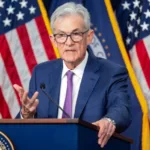By Petr Svab
The Federal Reserve has distributed more than $15 billion over the past four weeks to banks and money market funds simply for not investing the cash of theirs and their investors. The payouts have increased dramatically this year as the Fed is raising interest rates in an attempt to curb inflation.
The Fed is saying interest rates need to go up in order to curb demand for goods and services and thus lower the incentive for producers to raise prices. But the way the Fed goes about raising rates is virtually paying off the financial industry to lend and invest less.
Normally, money sitting in the accounts of a bank’s customers is just dead weight on the bank’s balance sheet, pushing the bank to make more loans. If banks want to make more loans, they generally have to offer lower interest rates. The way the Fed raises interest rates is by paying banks an interest on the money the bank agrees to keep dormant. The interest rate now stands at 3.15 percent, more than what a bank would have received on a standard residential mortgage a year ago.
In addition, the Fed uses transactions called “reverse repurchase agreements,” or “reverse repos,” to siphon some money out of the system. The central bank pays slightly lower interest on the reverse repos, but allows not just banks but also money market funds to participate.
Back in January, the Fed paid out some $600 million over four weeks in interest on deposits and reverse repos. In April, it was already $1.5 billion. In June, over $5 billion, and in August, nearly $11 billion. In the four weeks ended mid-October, the payout rose to more than $15 billion, for a year-to-date total of $45 billion. Depending on how aggressively the Fed continues to raise the rates, the price could accelerate still further.
The Fed can’t technically run out of money because it can create dollars electronically. Every dollar it creates, however, adds to inflationary pressures in the real economy or the financial markets, depending on where the money eventually ends up being spent.
Inflation has been running hot for months, oscillating around 40-year highs of over 8 percent, after the economy was inundated with trillions in extra government spending during the COVID-19 pandemic.
The Biden administration and Democrat-led Congress professed to address the issue with the Inflation Reduction Act. According to the Congressional Budget Office (CBO), the bill will have negligible effects on inflation this year, and may increase it or decrease it next year by up to 0.1 percent.
“Responsiveness to the enhancement of health insurance subsidies established by the Affordable Care Act is the most important factor boosting inflationary pressure, and responsiveness to the new alternative minimum tax on corporations is the most important factor reducing inflationary pressure,” CBO said in response to questions from Sen. Lindsay Graham (R-S.C.) in August (pdf).






